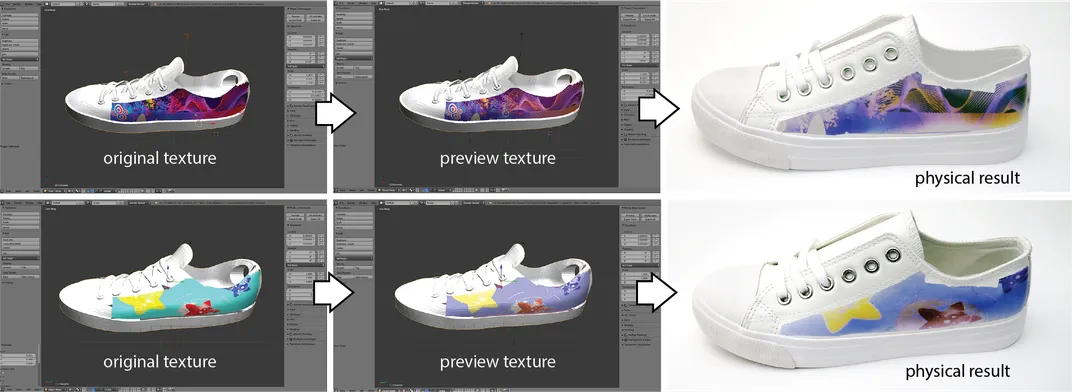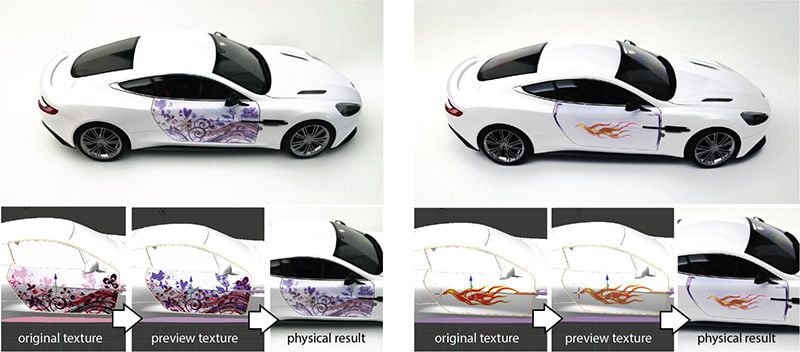This New Dye Changes Color When Exposed to UV Light
Color-change shoes, jewelry, cars, furniture and more could be possible with this new MIT technology
Do you love those shoes but can’t decide whether to buy the brown or the blue?
In the near-ish future, you may not have to decide.
A new technology from MIT’s Computer Science and Artificial Intelligence Laboratory (CSAIL) uses reprogrammable ink to change the color of ordinary objects. The system, dubbed “PhotoChromeleon,” uses photochromic dyes that change color when exposed to UV light.
“This special type of dye could enable a whole myriad of customization options that could improve manufacturing efficiency and reduce overall waste,” says CSAIL postdoctoral researcher Yuhua Jin, in a press release. “Users could personalize their belongings and appearance on a daily basis, without the need to buy the same object multiple times in different colors and styles.”

The team will present a paper on PhotoChromeleon next month at the User Interface Software and Technology symposium in New Orleans.
The system works like this: photochromic dyes in cyan, magenta and yellow, the standard set of pigments used in printing, are mixed into a sprayable solution. You spray the object—say, a shoe—with the ink. Then you place the object in a box with a projector and a UV and visible light source. The light saturates the colors, going from transparent to fully saturated. The projector does the reverse. The color of the object is determined by the wavelength of the light—for example, green light is absorbed by magenta dye, leaving yellow and cyan, resulting in a green object.
/https://tf-cmsv2-smithsonianmag-media.s3.amazonaws.com/filer/80/de/80dee8c9-086a-4c37-9a03-5318d5a97aca/3_chameleon_process_overview_1.png)
The team tested the system on a model car, a phone case, a shoe and a toy chameleon. The process of coloring the test objects took between 15 and 40 minutes. They also developed a user interface for creating special designs and patterns. Leopard-print shoes, anyone? When you want to change the color or pattern of the object, you simply put it back in the box, use the UV light to “erase” it, and start over.
Past projects involving reversible color-change technology have only been able to go from transparent to one color and back again. PhotoChromeleon is unique in that it can change between many colors.
Achieving this involved multidisciplinary collaboration, says CSAIL postdoctoral researcher Isabel Qamar. “The intersection between material science, optics and computer science, where expertise from all three areas have to be fused together, was the biggest challenge,” she says.
Qamar envisions a future where we can change clothes, shoes and accessories on a whim, make unique patterns on our cars, or even live in homes with reprogrammable furniture or walls. Goodbye, painting!

Warren Jasper, a professor of textile engineering at North Carolina State University, says people have been playing with color-change technology for decades, often for novelty products, such as heat-sensitive coffee mugs with patterns that appear when filled with coffee.
“It’s interesting, it’s a cool idea,” he says, of the MIT research. But for it to become commercially viable, the researchers will need to deal with how to keep the colors from fading in the sun, he says. And if they want to scale up, they’ll also need to find a more environmentally friendly alternative to the lacquer currently used to dissolve the photochromic dyes to make them sprayable. “People in the industry generally try to avoid those,” Jasper says.
Qamar says the team is indeed working on increasing the stability of the dyes so they last longer in outdoor light. They’re also looking at widening the range of colors achievable with the dye system—at the moment there’s no good way to make magenta, for example. Ultimately, the researchers are interested in experimenting with larger-scale applications where the dyes could be used directly in the manufacturing process.
So for now you’re still stuck choosing between those blue shoes and the brown ones. But in the future, the leopard print might be as easy as flicking on a light switch.
/https://tf-cmsv2-smithsonianmag-media.s3.amazonaws.com/accounts/headshot/matchar.png)


/https://tf-cmsv2-smithsonianmag-media.s3.amazonaws.com/accounts/headshot/matchar.png)